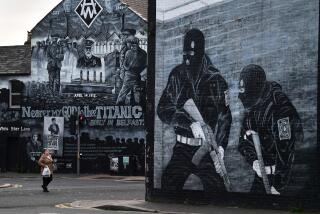Joe Cahill, 84; IRA Leader Who ‘Spent a Lifetime in Struggle’
- Share via
DUBLIN, Ireland — Joe Cahill, a founder of the modern Irish Republican Army who once narrowly avoided the hangman’s noose, has died, the IRA-linked Sinn Fein party said Saturday. He was 84.
Cahill died Friday in his Belfast home from asbestosis, a lung-ravaging condition he acquired while working in Belfast’s Harland & Wolff shipyards in the 1950s.
Cahill was the first Belfast commander of the so-called Provisional wing of the IRA, founded in December 1969, the year that Northern Ireland descended into decades of civil unrest.
He was also the principal mentor of Sinn Fein leader Gerry Adams, who served under Cahill in the early 1970s, when the IRA began killing British soldiers and police and bombing towns and cities in Northern Ireland and England.
After about 1,800 people were killed and thousands maimed, IRA commanders called open-ended cease-fires in 1994 and 1997 -- when Cahill’s vote in favor was considered critical.
“Joe Cahill spent a lifetime in struggle. He was both a leader and a servant of the republican cause,” Adams said.
“He was an unapologetic physical-force republican who fought when he felt that was the only option. But he also significantly stood for peace and was a champion of the Sinn Fein peace strategy.”
Cahill, born in Belfast in 1920, was sentenced to death alongside five other IRA members for killing a police officer in 1942. While one of his colleagues, Tom Williams, was hanged, Cahill and the others had their sentences commuted to life. British authorities freed him in 1949.
Cahill remained in the old IRA through a 1956-62 campaign. Like many northern hard-liners, he broke from the Dublin-based organization when it failed to defend Catholic parts of Belfast adequately from Protestant mob violence in August 1969.
Cahill quickly rose through the ranks of the fledgling Provos, as the new IRA wing was nicknamed. He also traveled to the United States to help found Irish Northern Aid, the Provisional IRA’s fundraising arm overseas.
In 1972 he became IRA chief of staff, the senior day-to-day command position, and moved to Dublin to avoid capture by British security forces.
He pioneered contacts with Libyan dictator Moammar Kadafi and, in March 1973, was caught by the Irish navy as he tried to smuggle five tons of Russian-made explosives, rifles, pistols and ammunition from Libya.
After being freed from prison in 1975, Cahill rejoined the IRA’s seven-member command alongside Adams and Martin McGuinness, another new-generation IRA commander. Cahill oversaw renewed contacts with Libya that led to four massive weapons shipments in the mid-1980s, much of which remains in secret IRA depots today.
Under the Adams-McGuinness leadership, the IRA modernized its practices and sought to develop Sinn Fein, its largely irrelevant political wing, into a substantial political party that supports reunification of Ireland. Sinn Fein began contesting elections in Northern Ireland in 1982 and the Republic of Ireland in 1987.
Cahill became the party’s treasurer, responsible for funneling money from U.S. supporters to Sinn Fein and the IRA. Cahill was deported from the United States after entering illegally in 1984.
Underscoring Cahill’s influence within IRA circles internationally, then-President Clinton gave Cahill an exceptional visa waiver to travel to the United States to reassure U.S. supporters immediately before and after the 1994 cease-fire declaration.
Cahill spoke out strongly in favor of accepting the Good Friday peace accord of 1998, which offered a chance for Sinn Fein to help govern Northern Ireland, a state the IRA had long hoped to abolish rather than reform.
But to his dying day, Cahill insisted that shifting Sinn Fein-IRA tactics would ultimately deliver the goal of uniting Ireland under one government, a goal that Northern Ireland’s Protestant majority opposes.
Sinn Fein said Cahill would be buried Tuesday in Milltown Cemetery in west Belfast, the final resting place for scores of IRA members, after services at nearby St. Paul’s Catholic Church. He is survived by his wife, Annie, and seven children.
More to Read
Sign up for Essential California
The most important California stories and recommendations in your inbox every morning.
You may occasionally receive promotional content from the Los Angeles Times.










